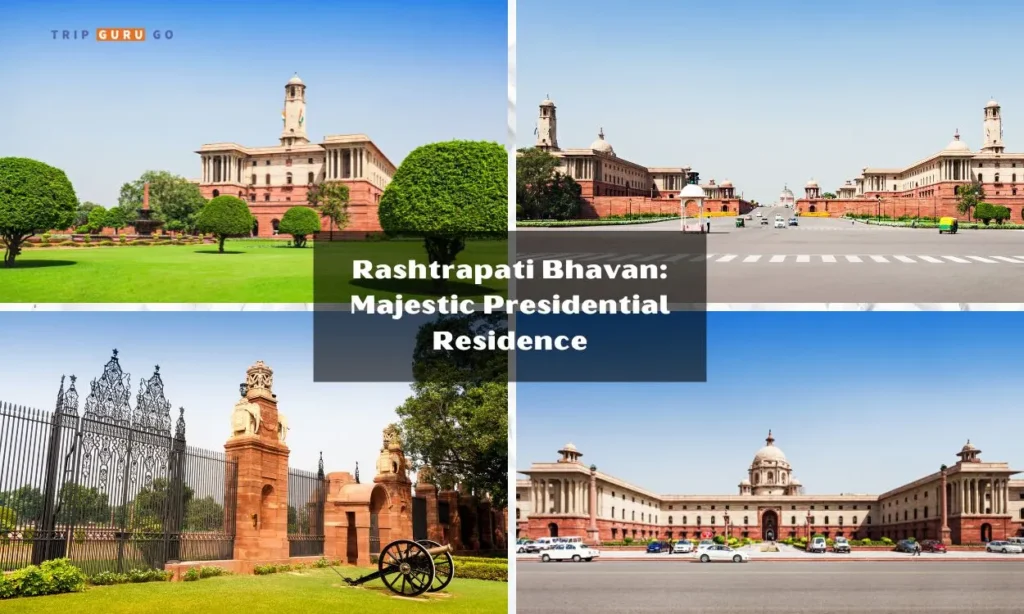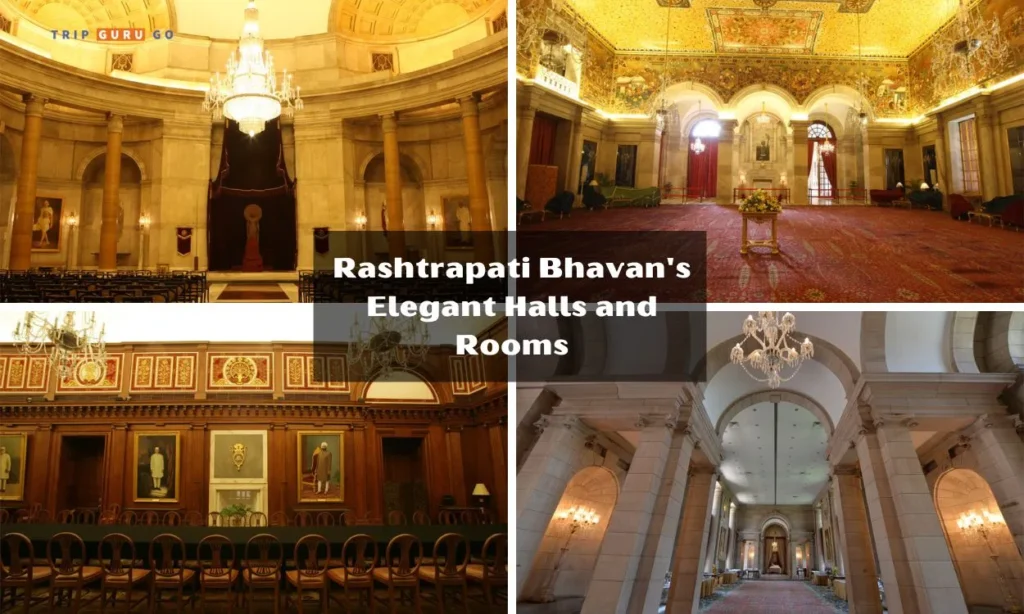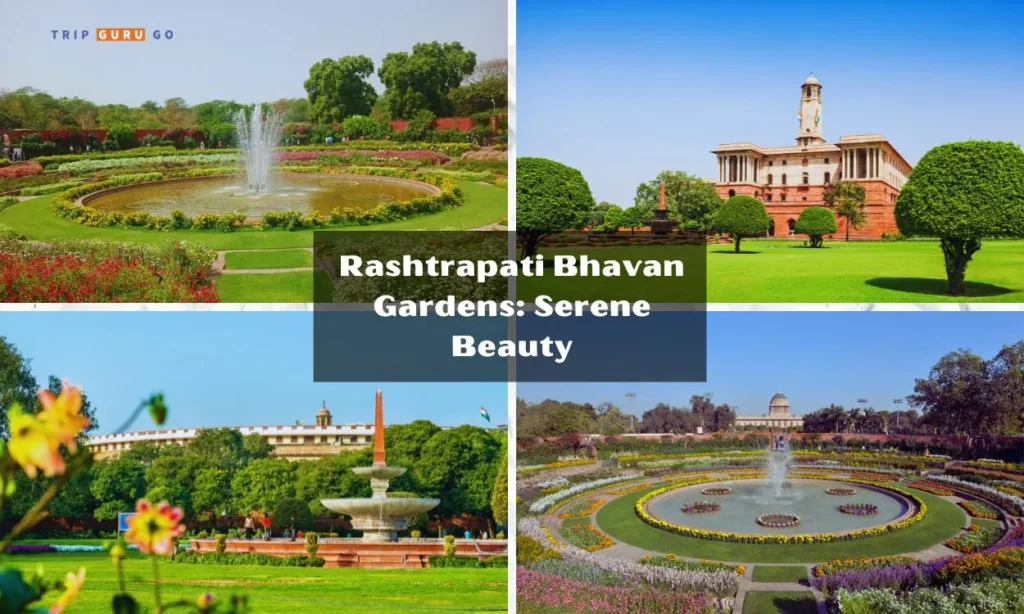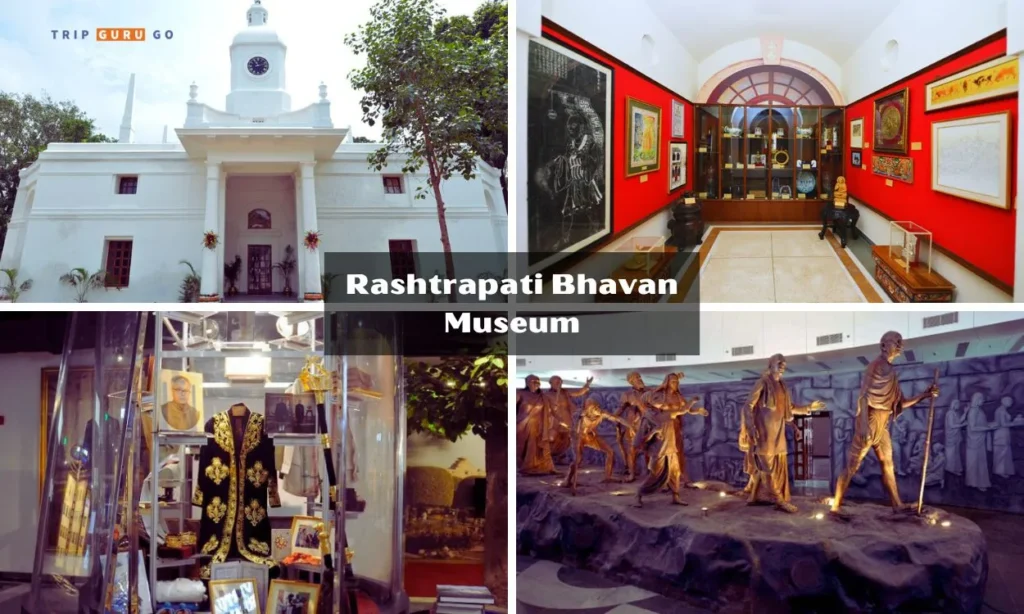Introduction:
The beautiful Rashtrapati Bhavan is right in the middle of India’s capital, New Delhi. It is well recognized as an emblem of freedom and democracy throughout the nation. This architectural wonder is the President of India’s official house, making it a well-known monument and an important part of Indian history.
Rashtrapati Bhavan, with its grandeur and elegance, shows how India has been, is now, and will be in the future. Its tall domes, intricate details, and large grounds show how a country has changed over time. As soon as you see its beautiful front, you feel awe and respect for the democratic way of life in the country.
Rashtrapati Bhavan has been home to important events and dignitaries from all over the world. It has furthermore witnessed in silence while India has moved from British rule to independence. There are lots of stories in the halls about choices that changed the direction of the country. Speaking of the Best places to visit in Delhi the president’s house stands as an iconic destination itself, offering a glimpse into history and architectural magnificence.
In this article, we try to learn more about Rashtrapati Bhavan, which is a building that is a work of art. We will learn about its interesting history, look closely at the small features that make it a work of art, and try to figure out what it means for our culture and country. Join us as we learn about Rashtrapati Bhavan’s long and interesting background, which makes it more than just a house. It stands for the strong freedom and rich culture of India.
Rashtrapati Bhavan Historical Journey:

Tracing the History of a Grand Legacy
From its beginnings at the height of the British Empire to its current status as the official residence of the President of India, Rashtrapati Bhavan’s history is a fascinating journey spanning centuries. Inside the walls of this historic building is a rich tapestry of events, decisions, and changes that have shaped the future of a country.
How an Idea Began
Lord Wellesley had the idea for Rashtrapati Bhavan. He desired for India to have a grand palace that radiated strength and authority. Between 1799 and 1803, the construction of this grand mansion, originally named the Government House, began. However, the shifting of India’s capital from Calcutta to Delhi during the Delhi Durbar in December 1911 set the stage for the prominence of Rashtrapati Bhavan.
A Monumental Shift
With the growth of New Delhi, the city next to Old Delhi, Rashtrapati Bhavan, became very important. They placed the palace on top of Raisina Hill, which provided it with a commanding view, and they purchased 4,000 acres of land to construct it. This was the start of a big project that would change the way India looks today.
Architectural Marvel by Lutyens
Edwin Landseer Lutyens, a well-known British architect and influential figure in city planning, was the creator of Rashtrapati Bhavan. This was a huge job. His vision included a grand, classical design with elements that drew inspiration from Indian architecture. Lutyens exerted considerable effort on different continents to ensure the construction of his architectural masterpiece, despite budget constraints forcing alterations to the original plans.
Getting New Looks and Names
Over the years, Rashtrapati Bhavan has undergone several changes and adaptations. The gardens were first made in the Mughal style, but over time, and after India got its independence, they changed. For a while, it was even called “Government House.” But on January 26, 1950, Rajendra Prasad moved in as the first President of India. This was a big change. During this important event, the palace’s name was changed to Rashtrapati Bhavan, which means “President’s House.” This shows that it is now a sign that India is an independent country.
The story of Rashtrapati Bhavan recounts its enduring impact and its significant role in shaping the country’s history, telling us of its profound influence on the nation’s past. This famous building shows how India has changed over time and how it will change in the future. It shows how strong a country is and how much it wants to change.
Rashtrapati Bhavan Architectural Marvel:
Getting New Looks and Names
Rashtrapati Bhavan is an amazing example of how art and architecture can work together. It stands within a spacious garden, capturing the interest of all who see it due to its intricate Rashtrapati Bhavan architecture, design, and impressive scale.
A mix of styles:
The architectural marvel of Rashtrapati Bhavan is based on a unique mix of Indian and Western styles. Designed during the Edwardian Baroque period, it combines the elegance of classical designs with the power and authority that are signs of imperial rule. The outside of the building shows a harmonious mix of styles, with traditional Indian elements and European elegance.
Careful Planning:
Rashtrapati Bhavan was carefully planned to have a large floor area of 200,000 square feet. It has four floors and 340 rooms, which is a lot. The building itself took an amazing 1 billion bricks and 3 million cubic feet of stone, with very little steel used. The dedication and skill of the craftspeople who made this building possible can be seen in the way they paid attention to details and made it look good.
Differentiating Features:
The building’s design was a long and complicated process that resulted in a structure that was both old and new. The walls are decorated with small, intricate jalis that are based on designs from Rajasthan. On the roof, traditional chhajjas and round stone basins remind us of India’s architectural history and its usefulness.
Meaning and Symbolism:
The central dome, which stands tall above the rest of the building, takes ideas from both Indian and British architecture. It looks like the famous Pantheon in Rome from the outside, and it has parts that look like early Buddhist stupas. This mix of symbols makes Rashtrapati Bhavan even more of a symbol of India’s long history and unity.
The Rashtrapati Bhavan is a wonderful building that shows how India is going from the past to the future. The different building types and attention to detail make it a truly amazing piece of art that still stands as a sign of the nation’s past and future.
Halls and Rooms in Rashtrapati Bhavan:
Within the opulent walls of the Presidential House, there are several halls and rooms that represent its varied functions as a ceremonial and administrative center. These Rashtrapati Bhavan rooms have witnessed important national events, diplomatic receptions, and historic moments.

1. Durbar Hall: A Throne of History
The most important place in Rashtrapati Bhavan is the Durbar Hall, located beneath the main building’s double dome. Before the country gained its independence, this hall housed two separate thrones for the Viceroy and Vicereine. Today, a single high chair symbolizes the Presidency, illuminated by the light of a 33-meter-high Belgian glass chandelier. The hall exudes grandeur with its chocolate-colored Italian marble floors and Delhi Order columns. One of the many significant events that occurred in this hall was the swearing-in of Jawaharlal Nehru on August 15, 1947, as India’s first Prime Minister. This hall stands as a testament to the historical significance of Rashtrapati Bhavan rooms.
2. Ashoka Hall: Where Art Meets Grandeur
Ashoka Hall is a rectangle of luxury that is 32 meters long and 20 meters wide. It was first built as a state ballroom with a wooden floor. On its ceiling is a bright Persian painting of King Fateh Ali Shah of Persia leading a royal hunting party. The fresco paintings on its walls and the luxurious way it is put together show the essence of grandeur and art.
3. Other Rooms and Spaces: A Spectrum of Purpose
Aside from the main halls, Rashtrapati Bhavan has a wide range of spaces that serve different purposes. The loggias have great views of the courtyards, and the dining hall can fit more than a hundred people. There are steps, living rooms, and game rooms, all of which are part of the building’s past. These places are used for political talks, cultural meetings, and showing people what Indian freedom is all about.
Dome of Rashtrapati Bhavan:
The dome is the most important part of Rashtrapati Bhavan. It is a beautiful mix of Indian and British architectural styles. This copper-faced wonder, which stands out from the building’s center, is both the physical and symbolic top of the building.
A View from Every Angle:
The dome is right in the middle of the building, between the four corners, so it can be seen from any angle. It stands out on the skyline because it is more than twice as tall as the structure itself. Lord Hardinge’s decision in 1913 to make the dome taller made this architectural masterpiece even more beautiful.
Fusion of Cultural Elements:
The dome’s design drew inspiration from a variety of sources, including classical, Indian, and Buddhist styles. One thing that stands out is the outside railing, which looks like the railings on early Buddhist stupas like Sanchi. Lutyens’ clever use of these elements creates a design that is both unique and harmonious, showing how different cultures and ideas can work together.
A Pantheon of Grandeur:
Although Lutyens drew inspiration from the Roman Pantheon, the dome’s resemblance to the Pantheon is more of an homage to its majesty than a direct copy. The central oculus lets light into the building’s interior, just like the ancient design it was based on. The dome looks even more heavenly because it has columns that are evenly spaced and a porch that goes around it.
Legacy and Symbolism:
The dome is not just an architectural flourish; it is also a symbol of India’s journey. It shows how the country has changed from when it was a colony to when it became an independent republic. Its completion in 1929 was a big deal, and its beauty still stands out on the skyline of the capital, showing how strong and democratic the country is.
Rashtrapati Bhavan Gardens and Landscapes: A Tranquil Oasis

Amrit Udyan: Combining the beauty of Mughal and English
The “Amrit Udyan” or “Garden of the Sacred Nectar” is a place inside the royal gates of the Rashtrapati Bhavan. This garden is full of peace and natural beauty. This beautiful Rashtrapati Bhavan park is also known as “Mughal Gardens”. This garden’s beauty comes from a mix of Mughal and English garden styles. You will find different types of plants and flower species in this garden. Seeing whom any person becomes mesmerized. The peace here makes it seem like a yogi has gotten lost in the thought of the divine. All these features make this place worth visiting in Delhi.
A Canvas of Beauty: Main Garden
The heart of Amrit Udyan is the main garden, which is a beautiful char bagh, or four-sided garden, made up of channels that cross each other. There are six lotus-shaped fountains at the crossings of these channels. The water jets from these fountains reach up to 12 feet into the air. The channels, doubling as reflective pools, mirror the vibrant blossoms that envelop them. And for the birds who live there, there are bird tables with grains all over, so they can eat while enjoying the beauty.
Terrace Garden: A Terrace of Splendors
From a higher vantage point, the terrace gardens embrace the main garden. On both the north and south sides of the main garden, these terraces give you a high view of the colorful landscape below. In the middle of each terrace are fountains, whose falling water sounds like a soothing symphony. At the ends of these terraces, gazebos and sentry posts blend form and function in a beautiful way.
The Veiled Beauty: Long Garden or ‘Purdah Garden
The mysterious “Purdah Garden” is to the west of the main garden. This enclosed paradise is a tribute to roses. Walls that are 12 feet high surround it. Sixteen rose beds with low hedges around them show off a colorful tapestry of colors. A red sandstone pergola with Rose creepers, Petrea, and Bougainvillea grows over the path in the middle. The walls are decorated with a living cascade of jasmine, Tecoma Grandiflora, Rhynchospermum, and other plants. China orange trees line the edges of this sanctuary, giving it a touch of foreign.
Latest News:
Note: Amrit Udyan, once known as the Mughal Gardens, will be open to everyone from August 16 to September 17. This lovely garden is at Rashtrapati Bhavan. It’s a special event called Udyan Utsav, and it’s the second time this year that people can visit. The garden is big, about 15 acres, and you can enter through Gate No. 35 on North Avenue Road.
Important info:
Open from 10 AM to 5 PM (last entry at 4:00 PM), except on Mondays. On September 5, Teachers’ Day, it’s open only for teachers to enjoy. Enjoy the beautiful garden and colorful flowers!
Rashtrapati Bhavan Museum: Unveiling Historical Treasures

A way to see the past and the present
Inside Rashtrapati Bhavan, you will find a museum. It is a gateway to the building’s rich history and beautiful architecture, which make it such an important landmark. Former President Pranab Mukherjee opened this museum. It talks about the lives and times of past presidents and shows how art, buildings, and Rashtrapati Bhavan have changed over the years.
Restoration: Preserving Heritage
The history of Rashtrapati Bhavan includes both how it was built and how it has been kept up. Careful work to fix this architectural masterpiece has given it a new lease on life. In 1985, architectural restorer Sunita Kohli started the first project to fix up the building. As later additions were taken away, Ashoka Hall returned to its original beauty. In 2010, architects Charles Correa and Sunita Kohli started a second repair job to keep this national gem safe and make it look new again.
Exploring Inside Rashtrapati Bhavan: Unveil the Grandeur
Plan to visit Delhi? Don’t miss the chance to see the amazing Rashtrapati Bhavan, which is a work of art that anyone can see. Inside this famous home, there is a world made up of three fascinating loops, each of which shows a different part of India’s history.
Circuit 1: Main Building and Central Lawn
Explore the best rooms like the Banquet Hall, Ashok Hall, and Durbar Hall to step into the heart of grandeur. In the North Drawing Room, Library, Navachar, and Long Drawing Room, you can learn about the past. With this route, you can see how beautiful the Forecourt and the main building are. It’s open on Thursdays, Fridays, Saturdays, and Sundays and takes you back in time to India.
Circuit 2: Rashtrapati Bhavan Museum Complex
The Rashtrapati Bhavan Museum Complex is a great place to learn about culture, art, and history. The Stables, The Garages, and The Clock Tower are all part of this amazing piece of Rashtrapati Bhavan architecture. Dive into a world of priceless artifacts that show what our history is all about. This route is a haven for people who love the unusual and is open every day except Monday.
Circuit 3: Gardens of Serenity in Rashtrapati Bhavan
Enjoy the rich beauty of the Mughal Gardens, which are known all over the world for their flower show. Visit the President’s house to see the Herbal Garden, the Musical Garden, and the Spiritual Garden. Every Thursday through Sunday from August to March, visitors come to these parks to take in their beauty.
The Change of Guard Ceremony: A Spectacle of Valor
Every Saturday and Sunday, the Rashtrapati Bhavan comes alive with the Change of Guard Ceremony. This tradition showcases the extraordinary skills of the President’s Bodyguard personnel – paratroopers and tankmen of unparalleled excellence. Witness their valor and military precision in a visual spectacle that redefines tradition for the public eye.
So, on your next visit to Delhi, dive into the elegance of Rashtrapati Bhavan, where history, culture, and awe-inspiring moments await your discovery.
Visitor information:
Here’s the visitor information in a concise format:
- Circuit 1
- Days: All days except Monday and Gazetted Holidays
- Timings: 09:00 AM – 04:00 PM
- Ticket: Rs. 50/- per visitor
- Address: Rashtrapati Bhawan, President’s Estate, New Delhi, Delhi 110004
- Circuit 2
- Days: All days except Monday and Gazetted Holidays
- Timings: 09:00 AM – 04:00 PM
- Ticket: Rs. 50/- per visitor
- Circuit 3
- Days: Opens During Udyan Utsav
- Timings: As per Udyan Utsav timings
- Ticket: Rs. 50/- per visitor
- Change of Guard Ceremony
- Days: Every Saturday
- Timings: 08:00 AM – 09:00 AM (Change of Guard: 08:00 AM – 09:00 AM)
- Ticket: N/A
Please be aware that Rashtrapati Bhavan may notify you of changes to the above schedule.
All circuits will close on statutory holidays.
Visitors under the age of 8 will be exempt from paying registration charges.
Rashtrapati Bhavan Ticket Price:
The Rashtrapati Bhavan ticket price varies, with charges starting at Rs. 50 per visitor for different circuits and groups.
- Individuals or less than 30 persons: Rs. 50 per visitor per Circuit.
- Group of 30 persons: Rs. 1200 per visit (Rs. 50 x 30 less 20% discount).
- Group of more than 30 persons: Rs. 1200 plus Rs. 50 per additional visitor.
- Visitors under 8 years old are exempt from registration charges.
Rashtrapati Bhavan Visit Timings:
- Thursday, Friday, Saturday, and Sunday: 9:00 AM – 4:00 PM
- Monday, Tuesday, and Wednesday, Gazetted Holidays: Closed
Change of Guard Ceremony Timings:
- On Saturday:
- 15 November to 14 March: 10:00 AM – 10:40 AM
- 15 March to 14 November: 08:00 AM – 08:40 AM
- On Sunday:
- 15 November to 14 March: 04:30 PM – 05:10 PM
- 15 March to 14 November: 05:30 PM – 06:40 PM
Guidelines for Visiting Rashtrapati Bhavan
To visit the Presidential House in Delhi, follow these steps:
1. Online Request for Visit:
- Request your visit to Rashtrapati Bhavan online at https://rb.nic.in/rbvisit/visit_plan.aspx.
- To witness the Change of Guard Ceremony, make an online request at the same website.
2. Entry Gates: Entry for visitors is through Gate No. 2 (Rajpath), Gate No. 37 (via Dalhousie Road-Hukmi Mai Marg), and Gate No. 38 (via Church Road-Brassy Avenue) of the Presidential House.
3. Required Documents:
- Indian visitors must carry a valid photo ID.
- Foreign visitors should request their visit and bring photocopies of their passports.
- Foreign visitors must also carry their original passport for verification on the day of the visit.
Explore the grandeur of Rashtrapati Bhavan while adhering to these simple instructions. Witness history, culture, and architecture come together in this iconic landmark.
Please note: For detailed information and requests, visit the provided website.
How to Reach Rashtrapati Bhavan
- By Metro: The easiest way to reach the Presidential House is by taking the Delhi metro. The nearest metro station to Rashtrapati Bhavan is the Central Secretariat on the Yellow Line, making it convenient for visitors. Once you arrive at the Central Secretariat, you can easily hop on an auto rickshaw to reach the Presidential House. You can catch either the Violet Line or the Yellow Line from the Central Secretariat metro station. This makes the Rashtrapati Bhavan nearest metro station an accessible starting point for your visit.
- By Bus: If you prefer buses, there’s a regular bus service from Delhi Transport Corporation (DTC) that goes to Rashtrapati Bhavan from all parts of the city. You can hop on buses like 100A, 604, 680, 720, 944, and 980. These buses will bring you quite close to the Presidential House.
Here are some nearby bus stations:
- Kendriya Terminal (9-minute walk)
- South Avenue (10-minute walk)
- Tyagraj Marg (12-minute walk)
- By autorickshaw: Delhi’s autorickshaw network is quite extensive. Just hop into an autorickshaw and let the driver know you want to go to Rashtrapati Bhavan. They’ll take you to one of the most stunning buildings in the world.
Getting to Rashtrapati Bhavan is convenient, whether you’re using the Delhi metro, bus, or auto rickshaw. Enjoy your visit to this architectural marvel!
Nearby Attractions of Rashtrapati Bhavan:
- India Gate: Find the nearby Grand War Monument, which is a popular place for picnics and long walks. Learn More
- National Museum: Immerse yourself in India’s rich history and culture at the nearby National Museum. Learn More
- National Gallery of Modern Art: Explore contemporary Indian art and sculptures at this nearby gallery. Learn More
- Lodhi Garden: At Lodhi Garden, which is just a stone’s throw away, you can enjoy quiet walks among peaceful greenery and ancient tombs. Learn More
- Gurudwara Bangla Sahib: At this important Sikh shrine close, you can find spiritual peace. Learn More
- Purana Qila (Old Fort): Step back in time at Purana Qila, an old fort with beautiful grounds that is close by. Learn More
- Connaught Place: Explore the vibrant atmosphere of Connaught Place, a bustling commercial hub in close proximity. Learn More
- Humayun’s Tomb: Humayun’s Tomb is a nearby UNESCO site with beautiful Mughal buildings and green grounds. Learn More
These attractions provide a diverse range of experiences near Rashtrapati Bhavan, making it an ideal starting point for your Delhi exploration.
Conclusion:
From its regal architecture to its lush gardens, Rashtrapati Bhavan embodies India’s legacy. Its halls echo with history, its gardens offer serenity, and its museum unveils leadership’s essence. Include the Presidential House in your journey to experience a tapestry of India’s past, present, and democratic spirit.
FAQs:
Visit the official website and follow the booking process. Choose the circuit, select the date, and make your reservation.
You can enter Rashtrapati Bhavan by booking a guided tour through the official website.
Presidential House is located in Delhi, the capital of India.
Rashtrapati Bhavan was designed by British architect Edwin Lutyens.
It’s named Rashtrapati Bhavan because it functions as the official residence of the President of India, who is also known as “Rashtrapati.”
Yes, Rashtrapati Bhavan is open for guided public tours on specific days and times.
Rashtrapati Bhavan has 340 rooms spread over four floors.
Yes, the Indian Presidential House is larger in terms of area compared to the White House.
Photography is restricted inside Rashtrapati Bhavan for security and preservation reasons.
Yes, visitors can explore designated areas inside Rashtrapati Bhavan through guided tours.
Lord Irwin, the then Viceroy of India, was the first occupant before it became the official residence of the President.
Rashtrapati Bhavan was primarily constructed using 1 billion bricks, 3,000,000 cubic feet of stone, and minimal steel.
Central Secretariat Metro Station is the closest station to Rashtrapati Bhavan.
No, photography inside Rashtrapati Bhavan is restricted for security and conservation reasons.





